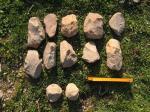Summary (English)
The excavation of the prehistoric mine of Poggio Malinverno (Allumiere), on the Monti della Tolfa, is part of a research project run by the German Institute of Archaeology, aimed at identifying prehistoric copper mining activities in central Italy.
The site of Malinverno, where the remains of an 18th century galena mine are still visible, was chosen following a survey in 2010 during which numerous stone mallets, indicative of prehistoric mining, were found. A number of trenches of different dimensions were dug in various points of the mining complex.
The excavations uncovered numerous roughly made stone hammers in the trench positioned close to the site’s access road, where they were also found during the survey. They were found in layers about 20-30 cm thick. Some of the hammers seemed to have been displaced by the construction of a small road at the end of last century, which crossed the excavation area and the prehistoric settlement.
An outcrop of copper bearing minerals was discovered in the south-western part of the mining area. The excavation identified several fills of ancient pits and trenches, of the type seen in open face prehistoric mines. A mineshaft was also identified, filled with dark soil containing a number of prehistoric brown impasto pottery fragments. The ancient open face mining activities carefully follow the direction of the copper bearing vein. However, as in all prehistoric mines, almost no finds were recovered. What may be a prehistoric settlement was identified at only 50 m from the mine face.
- Claudio Giardino - Università del Salento (Lecce)
- Daniel Steiniger - Istituto Archeologico Germanico, Roma
Director
Team
Research Body
Funding Body
- Fritz-Thyssen-Stiftung
- Istituto Archeologico Germanico di Roma






![Download [PDF]](/excavation/skins/fasti/images/results/download_sml.png)